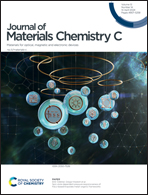Self-reducing molecular ink for printed electronics and lithium-ion battery cathodes as conductive binder†
Abstract
Particle-free metal–organic-decomposition inks, especially amine-coordinated copper formate compounds, can be employed as highly conductive binder precursors to replace the commonly used polymer adhesives. Herein, we used the copper formate complex (Cuf-C) as the conductive binder precursor instead of organic binders and dispersants to prepare a series of composite inks. The lowest voltage solid block resistance of the graphene composite conductive ink was 7.34 Ω per sq per mil. In addition, we applied the pyrolysis products of Cuf-C to the cathode of lithium-ion batteries as conductive binder. Compared with the traditional poly(vinylidene fluoride) binder, the battery with the Cuf-C binder displayed lower charge transfer resistance and interface impedance at the cathode/electrolyte interface, as well as lower polarization and better electrochemical kinetics. We also observed the positive effect of the Cuf-C binder on the cathode in finite element simulation.



 Please wait while we load your content...
Please wait while we load your content...